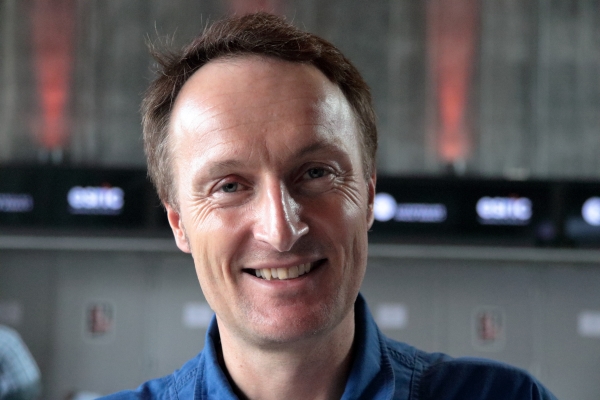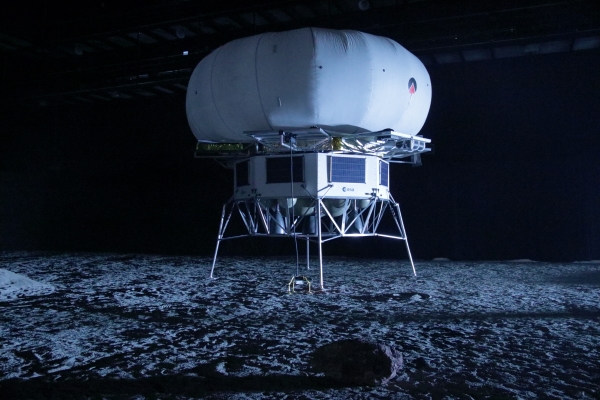 Matthias Maurer, ESA Astronaut;
Credit: Kangkan Halder
Matthias Maurer, ESA Astronaut;
Credit: Kangkan Halder
On Friday 9 September 2022, the five winning teams of the Phase 1 of Space Resources Challenge, organised by the European Space Agency (ESA) and the European Space Resources Innovation Centre (ESRIC), came together again to test their lunar rover prototypes to compete on a 1,800 m2 "lunar" terrain temporarily set up in Rockhal in Esch-Belval, Luxembourg (below).
Located at the Maison de l'innovation in Esch-Belval, ESRIC is a joint initiative of the Luxembourg Space Agency (LSA), the Luxembourg Institute of Science and Technology (LIST) and the ESA.
The final winning team of the Space Resources Challenge will receive up to €550,000 in development contracts from ESA and ESRIC and get the possibility to fly their final robot on the Moon. The jury who will select the final winning team includes ESA Astronaut Matthias Maurer, who returned on 6 May 2022 from a nearly six-month (177-day) stay on board the International Space Station (ISS).
Talking to Chronicle.lu during his visit to Esch-Belval on Friday, Mr Maurer explained that the importance of the current event, a competition which is open to the public, industries and research institutions, is to find innovative technologies to prospect resources on the Moon. He said: “We are currently on the brink of flying again to the Moon and in the Artemis programme, we will bring humans to the Moon and stay on the Moon. In the long run, we want to make a moon station and explore the Moon further … but we cannot fly everything to the Moon”. He indicated that new technologies are needed to sustain humans on the Moon surface and that includes prospecting what is there and how to use these resources. He continued: “We would need technologies to find water on the Moon, not only to drink but also [we] need technology to split water (H2O) into hydrogen (H2) and oxygen (O2)”. He elaborated that hydrogen is a clean and efficient source of energy, and can be used as rocket fuel as well, whilst oxygen can be used to breathe.
Matthias Maurer added that to stay longer on the Moon, humans would need to build stations to protect themselves from radiations and these stations would be probably built by 3D-printing using lunar soil, rather than flying materials from the earth, and hence new technologies are needed to prospect the resources on the Moon and learn how to use these resources. He then explained that current technologies limit humans to be outside a space station for only seven hours or so and therefore it is logical to send rovers first to scout and prospect the best landing sites with the best resources nearby. Moreover, while humans can probably do much more than a rover in much shorter time on the Moon, a rover can stay on the Moon for a very long time, giving them the advantage to prospect large areas. Thus, the current ESA-ESRIC Speace Resources Challenge event and efforts to find new technical innovations are important for this long-term goal.
In continuation of prospecting resources and building a station on the Moon, Mr Maurer was optimistic about Luxembourg’s space mining ambitions as well. He explained that once a station is built and the nearby resources are known, humans will also need to learn “how to extract and build new things or make fuel on the Moon, for example”. He clarified that the possibility of refuelling on the Moon is exciting and more logical because there is less gravity on the Moon and therefore less energy is needed to leave the Moon’s atmosphere than refuelling on Earth. He also mentioned that these technologies, which can work in a vacuum and dusty environment, can then be transferred to asteroid extraction as well, for precious metals or extending science and our understanding of the universe. He argued: “The Moon will be the perfect place where you can test and prove these technologies. Luxembourg can contribute to the objectives of ESA, exploring the Moon, scientific purposes while at the same time maturing the hardware and technology. So that is a win-win situation.”
When asked about his experience in relation to a nearly seven-hour of space walk on 23 March 2022, also known as extravehicular activity, which includes several upgrades and changes on the exterior of ISS, Matthias Maurer explained that to work outside the station, one needs a space suit which is pressurised (0.3 atm), which makes it like feel something like inside a car tyre. Therefore, anything you do or move feels much harder and the muscles fatigue faster and secondly, safety is the top priority during these times and astronauts are harnessed to two points at all time. This constant attention to safety and precise work also means the brain has to be fully active at all times. Moreover, alone in the vast space and looking down on the Earth, he recalled that “the first minutes,you might get the impression that I am falling. As a beginner, it is also a challenge to remain calm". Overall, Mr Maurer felt that the space walk was a tremendous experience coupled with fatigue and exhaustion, and concluded “It was a really good day, the best day of my 177 days in space”.
Offering his guidance and an inspirational message for children, the 52-year-old astronaut said: “You need to dare to dream big dreams and don’t let anybody tell you that you cannot do it. You just need to strive and have ambition, and don’t give up”.
The Space Resources Challenge opened to the public on 7 May 2021 for application submissions and ESA and ESRIC invited thirteen teams to the first field-test in the Netherlands on 29 August 2021. Of these, ten were selected to submit their final proposal on 29 October 2021. Five winning teams were chosen in January 2022 and given a €75,000 development contract each to develop their prototypes further.
The five competing teams were:
- FZI - Forschungszentrum Informatik, Karlsruhe, Germany
- ETH Zurich & University of Zurich, Switzerland
- Lukasiewicz – PIAP, Poland
- Mission Control Space Services, Canada
- Space Application Services & University of Luxembourg & Dynamic Imaging Analytics & La Palma Research Centre & University de Lorraine & The Open University
The final winner will be announced in about five to six weeks’ time, in October 2022.









